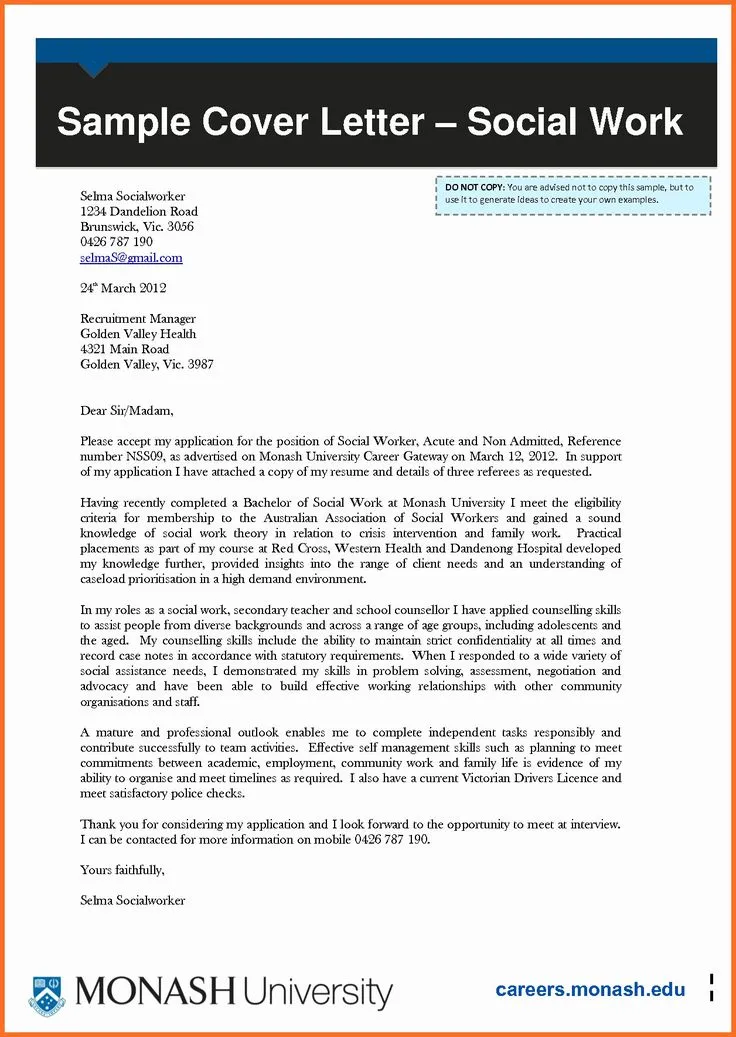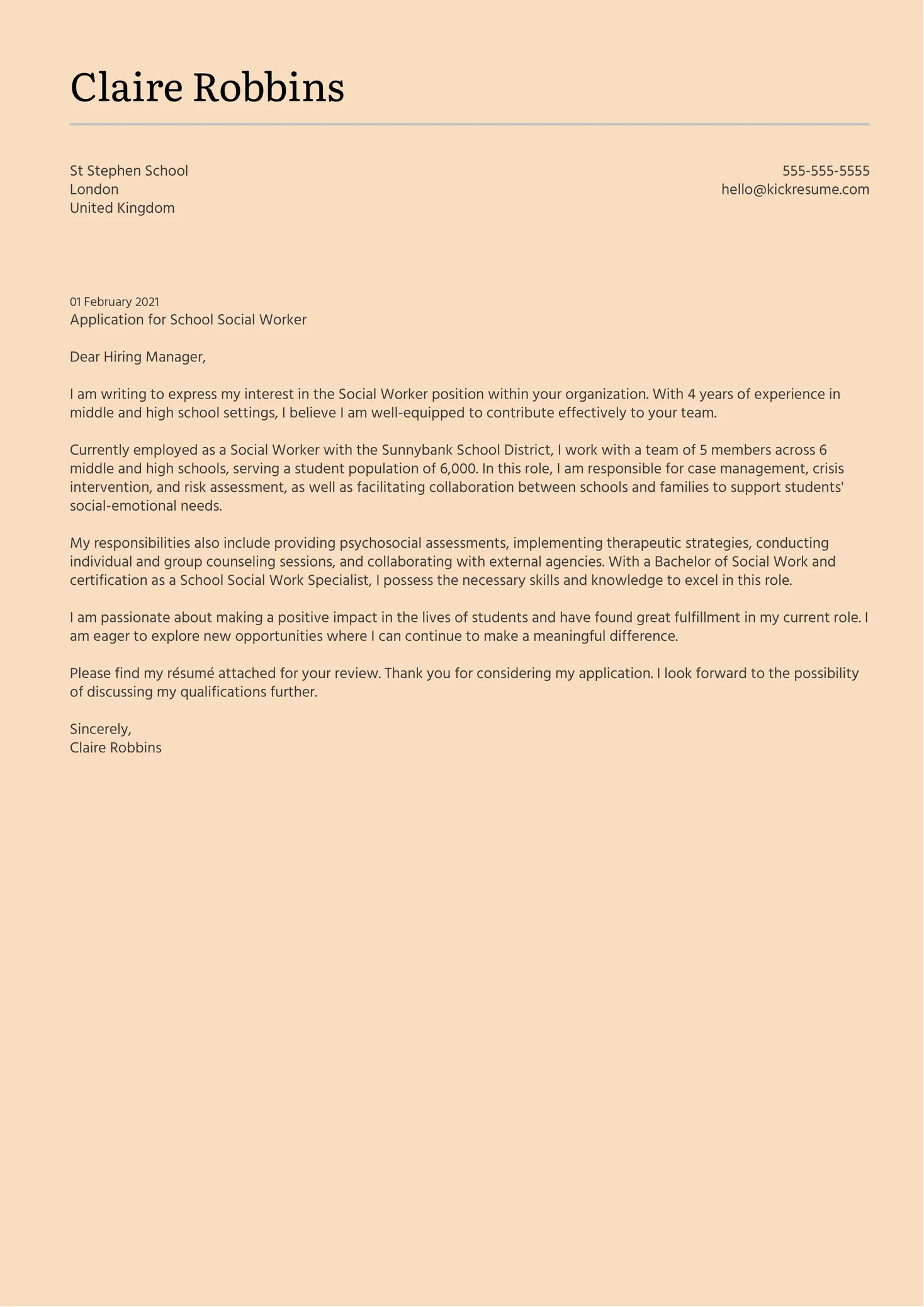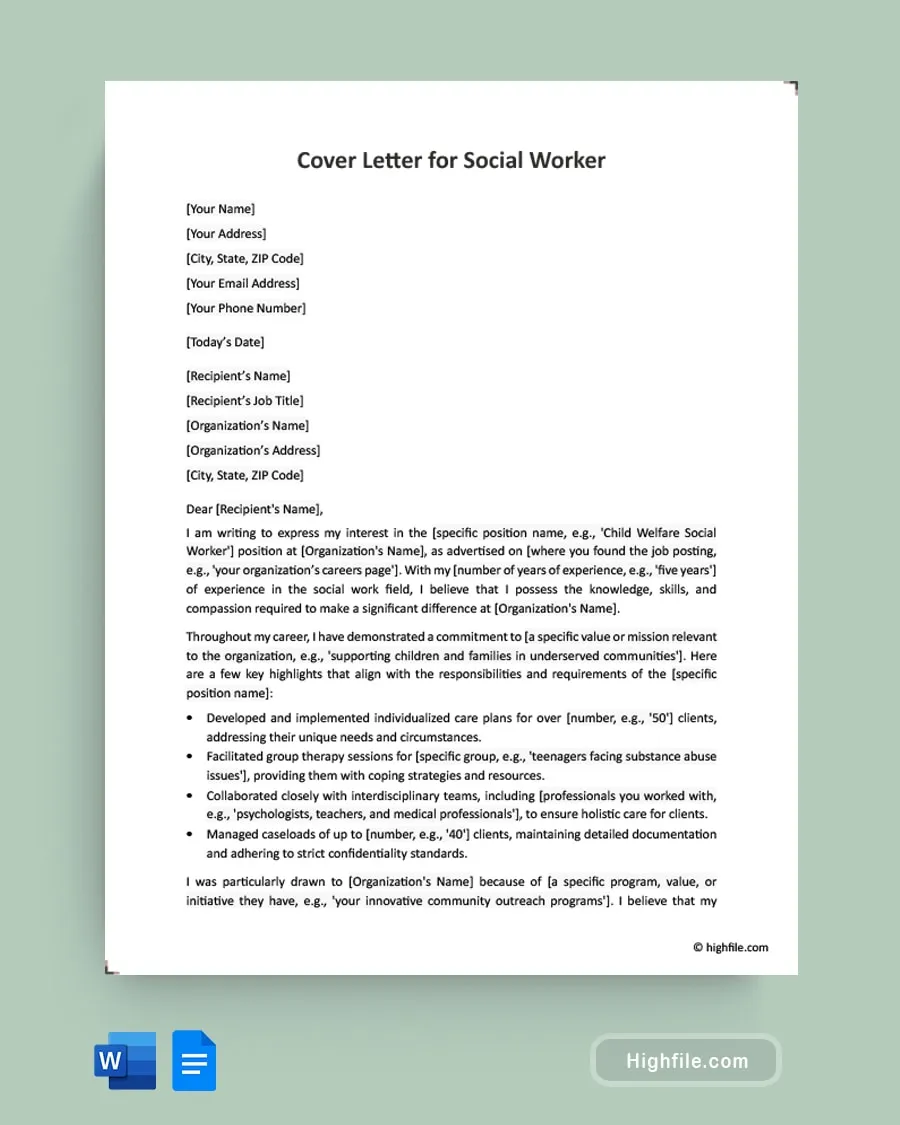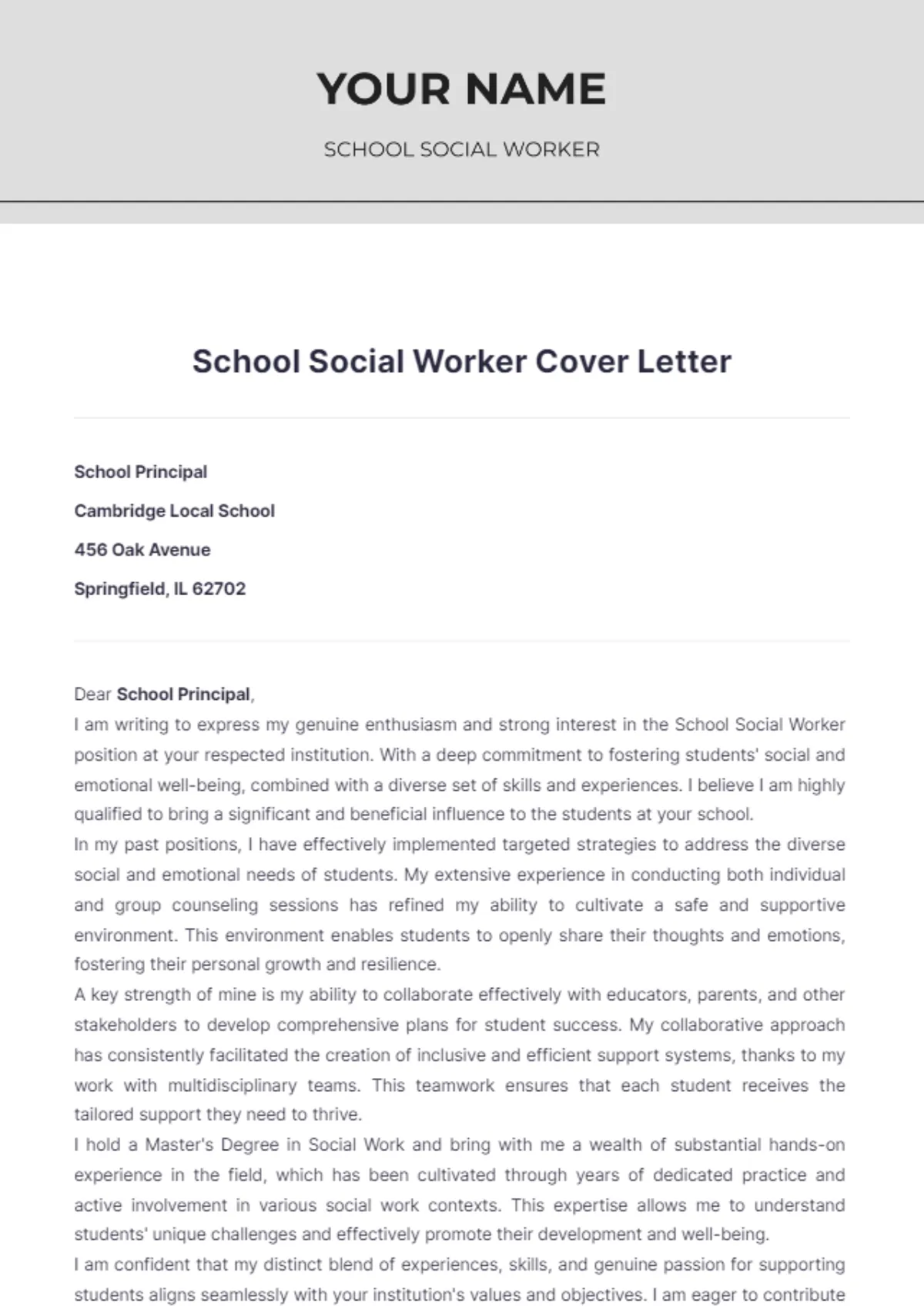The Power of a School Social Worker Cover Letter
A compelling cover letter is your first opportunity to make a positive impression on a potential employer. For school social workers, a well-crafted cover letter is even more crucial. It is not just a formality; it is a powerful tool that can significantly increase your chances of landing an interview and ultimately, securing your dream job. Your cover letter allows you to showcase your unique skills, experience, and passion for helping students and their families within the school environment. It’s where you can tell your story, highlight your qualifications, and demonstrate why you are the ideal candidate for the position. Moreover, a well-written cover letter shows your attention to detail, communication skills, and professionalism—all essential qualities for a school social worker.
Understanding the Role of a School Social Worker
Before diving into cover letter specifics, understanding the multifaceted role of a school social worker is essential. School social workers are vital members of the educational team, providing a range of services to support student success and well-being. They act as liaisons between the school, home, and community, addressing students’ social, emotional, and academic needs. This includes working with students, families, teachers, and administrators to create a supportive and inclusive school environment.
Key Responsibilities of a School Social Worker

School social workers have several key responsibilities. They conduct individual and group counseling sessions, assess students’ needs, and develop intervention plans. They also connect families with resources, such as mental health services, food assistance, and housing support. Furthermore, school social workers advocate for students’ rights and needs, collaborate with teachers and staff to address behavioral issues, and participate in crisis intervention. They also play a crucial role in preventing dropouts, promoting attendance, and ensuring students’ academic success. Highlighting these responsibilities shows that you understand the role’s importance.
Top 5 Cover Letter Secrets for School Social Workers
Highlighting Your Skills and Experience
One of the most important secrets is to effectively highlight your skills and experience. Your cover letter should be a showcase of your qualifications. Clearly articulate your relevant skills, such as counseling, crisis intervention, case management, and knowledge of child development. Back up your claims with specific examples from your previous experiences. Describe how you successfully managed challenging situations, supported students’ mental health, or collaborated with families. Quantify your achievements whenever possible. For instance, if you improved student attendance rates or reduced disciplinary incidents, provide the numbers to demonstrate your impact. Make sure to match your skills with the job description’s requirements.
Tailoring Your Letter to the School

Generic cover letters rarely impress. Tailoring your letter to each school is crucial. Research the school’s mission, values, and specific needs. Show that you understand the school’s culture and are interested in contributing to its unique environment. If the school has a particular focus, such as serving students with disabilities or promoting social-emotional learning, address this in your letter. Explain how your skills and experience align with the school’s priorities. Mentioning specific programs or initiatives the school is involved in shows your genuine interest and attention to detail. Personalizing your cover letter demonstrates your commitment and increases your chances of standing out from the crowd.
Showcasing Relevant Achievements
Don’t just list your responsibilities; showcase your achievements. Use the cover letter to highlight what you’ve accomplished in previous roles. Did you implement a new program that improved student outcomes? Did you successfully resolve a conflict between students or families? Did you secure funding for a valuable resource? Use the STAR method (Situation, Task, Action, Result) to structure your examples. Describe the situation you faced, the task you were assigned, the actions you took, and the results you achieved. This method helps you provide clear, concise, and impactful examples of your abilities. Focus on achievements that are directly relevant to the school social worker position, demonstrating your ability to make a positive impact.
Using Action Verbs Effectively
Action verbs make your cover letter more dynamic and engaging. Start your sentences with strong action verbs that describe your accomplishments and skills. Instead of saying ‘Responsible for case management,’ write ‘Managed a caseload of 50 students, providing individual and group counseling.’ Here are some effective action verbs you can use: Advocated, Assessed, Collaborated, Counseled, Coordinated, Developed, Facilitated, Implemented, Improved, Led, Mentored, Organized, Provided, Supported, Trained. Using these verbs creates a sense of energy and shows that you are proactive and results-oriented. The correct choice of words makes your cover letter more memorable and makes you a more attractive candidate.
Maintaining a Professional Tone

Maintain a professional tone throughout your cover letter. While expressing your personality is important, always use formal language and avoid slang or overly casual expressions. Proofread your cover letter carefully to eliminate any grammatical errors or typos. Ensure your letter is well-structured, with clear paragraphs and concise sentences. Address the letter to the hiring manager or the person specified in the job posting. If you can’t find a specific name, use a professional salutation, such as ‘Dear Hiring Committee.’ Your cover letter is a reflection of your professionalism and attention to detail. Showing this kind of care improves your chances of being noticed by the decision-makers.
Cover Letter Structure for School Social Workers
Header and Contact Information
Start with a header that includes your name, address, phone number, and email address. This information should be at the top left or right corner of your cover letter. Make sure your contact information is up-to-date and professional. If you have a LinkedIn profile, include the link in your header. This makes it easy for the hiring manager to learn more about your professional background. Keep it clean and easy to read. The header is the first thing the reader sees, so make it a good one.
The Salutation

Address your cover letter to the hiring manager if possible. Use their name and title, such as ‘Dear Mr. Smith, School Principal.’ If you can’t find the name, use a professional salutation, such as ‘Dear Hiring Committee’ or ‘Dear School Social Work Department.’ Avoid generic salutations like ‘To Whom It May Concern.’ It makes your cover letter feel impersonal. Personalizing the salutation shows you have done your research and are attentive.
Opening Paragraph Crafting
Your opening paragraph should grab the reader’s attention and clearly state the position you are applying for. Briefly mention where you found the job posting. Express your enthusiasm for the position and the school. State your key qualifications and briefly explain why you are a good fit. Keep it concise and to the point. The opening paragraph sets the tone for your cover letter, so make it impactful and engaging.
Body Paragraphs Content
The body paragraphs are where you highlight your skills, experience, and achievements in detail. Use a few paragraphs to showcase your qualifications. Focus on the requirements listed in the job description. Provide specific examples of how you have successfully performed relevant tasks. Use the STAR method to structure your examples, focusing on achievements and quantifiable results. Tailor your examples to the specific needs of the school. The body paragraphs are the most important part of your cover letter. They convince the hiring manager that you are the best candidate for the job.
Closing Paragraph and Call to Action

In your closing paragraph, summarize your interest in the position and reiterate your qualifications. Thank the hiring manager for their time and consideration. Include a call to action, such as expressing your availability for an interview. Provide your contact information again. End with a professional closing, such as ‘Sincerely’ or ‘Best regards,’ followed by your name. Make sure your closing paragraph leaves a lasting positive impression.
Additional Cover Letter Tips
Proofreading and Editing
Proofread your cover letter multiple times. Check for grammar, spelling, and punctuation errors. Errors can detract from your credibility. Use a spell checker and grammar checker. Have a friend or colleague review your cover letter. A fresh pair of eyes can catch mistakes that you might have missed. A well-proofread cover letter shows you pay attention to detail and are committed to providing high-quality work. Proofreading ensures your cover letter reflects your professionalism.
Formatting for Readability

Format your cover letter for readability. Use a clear and professional font, such as Times New Roman, Arial, or Calibri. Use a font size between 10 and 12 points. Use single-spaced text with a space between paragraphs. Keep your paragraphs concise and to the point. Use bullet points to highlight your achievements and skills. A well-formatted cover letter is easy to read and makes a positive impression. Proper formatting makes it easy for the hiring manager to quickly understand your qualifications.
Submitting Your Cover Letter
Follow the instructions provided in the job posting for submitting your cover letter. If the posting requires an online application, ensure your cover letter is formatted correctly and is attached properly. If submitting via email, use a professional subject line and include your cover letter as an attachment (PDF is recommended). Always save your cover letter with a professional filename, such as ‘YourName_CoverLetter_SchoolSocialWorker.’ Ensure your submission is complete and meets all the requirements. Submitting your cover letter correctly demonstrates your ability to follow directions and your attention to detail, making you a more desirable candidate.
By following these cover letter secrets, school social workers can significantly increase their chances of landing their dream jobs. A well-crafted cover letter is more than just a formality—it is a powerful tool to showcase your skills, experience, and passion for supporting students and families. Take the time to tailor your letter, highlight your achievements, and maintain a professional tone. By doing so, you will be well on your way to securing a rewarding career in the field of school social work.
